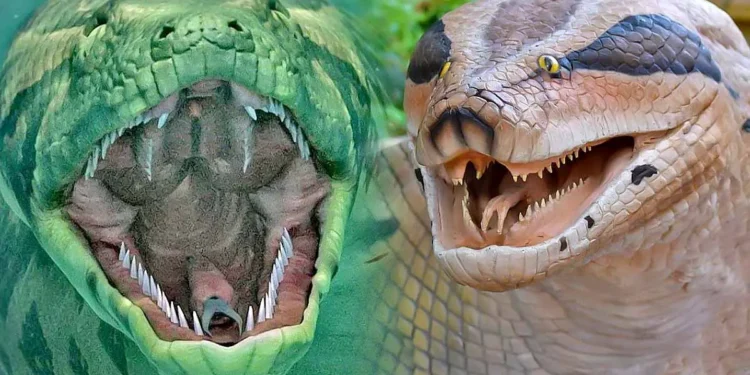Imagine a snake so huge it could swallow a crocodile whole. This isn’t fiction but the real creature known as Titanoboa. It lived over 60 million years ago and holds the title of the largest snake ever discovered. Let’s dive into the world of this massive serpent and uncover its story.
What Was Titanoboa?
Titanoboa was a giant snake that lived during the Paleocene Epoch, around 60 to 58 million years ago. This era occurred after the extinction of the dinosaurs, making Titanoboa one of the top predators of its time. Its name, Titanoboa cerrejonensis, means “titanic boa from Cerrejón,” and it was named after the location where its fossils were found in Colombia. This snake is closely related to modern-day boas and pythons, but it was much larger and more fearsome.
In its time, Titanoboa was a true giant of the animal kingdom. It dominated the swampy rainforests of ancient South America, where it ruled the food chain. Unlike most snakes we know today, which rely on venom, Titanoboa likely killed its prey through constriction, using its immense size and strength to crush animals before swallowing them whole.
How Big Was Titanoboa?
Titanoboa was truly massive. Scientists estimate that this prehistoric snake could grow up to 42 feet long and weigh over 2,500 pounds. To put that in perspective, the largest snake alive today, the green anaconda, rarely exceeds 30 feet in length and 550 pounds in weight. Titanoboa was not only longer but also significantly heavier and thicker than any modern snake.
With such a colossal size, Titanoboa’s body was about the width of an adult human’s waist. It likely had the strength to take down large animals such as crocodiles and giant turtles, making it a top predator in its ecosystem. Its sheer size gave it an enormous advantage in hunting, and its environment provided the perfect conditions for such a massive creature to thrive.
Where Did Titanoboa Live?
Titanoboa lived in the tropical rainforests of what is now modern-day Colombia. During the Paleocene, this region was much warmer and wetter than it is today, creating the ideal environment for a snake of Titanoboa’s size to survive. The area where Titanoboa lived, known as the Cerrejón Formation, was a lush swampy forest, rich with vegetation and home to a variety of ancient creatures.

This environment allowed Titanoboa to grow to such an enormous size, as the warm climate supported the metabolic needs of cold-blooded reptiles. The abundance of prey, including large fish, turtles, and crocodiles, made this region a paradise for the mighty snake. It is believed that Titanoboa spent much of its time in the water, similar to modern anacondas, using its massive body to ambush prey.
Titanoboa’s Fossil Discovery
Titanoboa remained hidden from the world for millions of years until an extraordinary fossil discovery was made in 2009. A team of scientists led by Jonathan Bloch and Carlos Jaramillo unearthed the remains of this giant snake in the Cerrejón coal mines of Colombia. The fossils included vertebrae and ribs, which allowed scientists to reconstruct the size and shape of Titanoboa.
This discovery was groundbreaking, as it provided the first evidence of such a massive snake. The fossilized bones were so large that the researchers initially thought they belonged to a crocodile. However, further analysis revealed that they belonged to a snake, and the sheer size of the fossils stunned the scientific community.
What Did Titanoboa Eat?
Titanoboa was a carnivore, and its diet likely consisted of large animals that lived in the same region. Given its massive size, it would have had no trouble taking down large prey. Scientists believe that Titanoboa primarily fed on fish and crocodiles, which were abundant in the swampy waters where it lived.
Using its powerful muscles, Titanoboa would constrict its prey, much like modern boa constrictors and anacondas. Once the prey was immobilized, the snake would open its jaws wide and swallow it whole. Its flexible ligaments allowed it to consume prey much larger than its head.
How Scientists Studied Titanoboa
After discovering the fossils, scientists began a detailed study of Titanoboa. Using modern technology, including 3D modeling, they were able to reconstruct the size, weight, and even the behavior of the snake. By comparing the fossilized bones to those of modern snakes, researchers could estimate Titanoboa’s size and determine how it lived.
Paleontologists also studied the surrounding fossils in the Cerrejón Formation to learn more about the environment in which Titanoboa thrived. These studies provided insights into the climate, vegetation, and other creatures that lived alongside the giant snake, offering a more complete picture of the ancient world.
When Did Titanoboa Go Extinct?
Titanoboa went extinct approximately 58 million years ago, likely due to changes in the climate. As the Earth cooled and dried, the warm and humid environment that supported Titanoboa disappeared. The swamps and rainforests where it lived shrank, and the availability of prey decreased, making survival more difficult for such a massive creature.
Additionally, the emergence of new predators and competitors may have contributed to Titanoboa’s extinction. Smaller, more adaptable reptiles, birds, and mammals began to dominate the ecosystem, leaving less room for a giant snake-like Titanoboa.
Could Titanoboa Still Exist Today?
While the idea of a giant snake like Titanoboa still roaming the Earth is a fascinating thought, it is highly unlikely. The environmental conditions that allowed Titanoboa to grow to such a massive size no longer exist. The cooler temperatures and changes in habitat would make it difficult for such a large reptile to survive in today’s world.
However, some people speculate that creatures similar to Titanoboa could still exist in unexplored parts of the Amazon rainforest or deep in the oceans. Despite these claims, no scientific evidence has been found to support the existence of any living Titanoboa or similarly large snakes.
How Was Titanoboa Discovered?
The discovery of Titanoboa was a monumental event in paleontology. In 2009, scientists working in the Cerrejón coal mines of Colombia made the incredible discovery of Titanoboa’s fossils. The excavation site was rich in fossils, and researchers were able to recover a significant portion of Titanoboa’s skeleton, including its vertebrae and ribs.
:focal(320x241:321x242)/https%3A%2F%2Ftf-cmsv2-smithsonianmag-media.s3.amazonaws.com%2Ffiler_public%2F9b%2F1f%2F9b1f861e-3b4c-42b3-85c0-9ec96057a61b%2Ftitanoboa_model.jpg)
The fossils were preserved in the coal deposits, which helped protect them over millions of years. By carefully analyzing these fossils, scientists could reconstruct the giant snake and learn about its life and environment.
How Fossils Are Found
Fossils like those of Titanoboa are often found in sedimentary rock layers, which form from the accumulation of sediment over time. When an animal dies, its remains may become buried by sediment, and over millions of years, the bones or other hard parts can fossilize. The discovery of fossils often requires careful excavation, and sometimes, as with Titanoboa, fossils are found by accident during mining or construction work.
Once discovered, fossils are carefully extracted and studied by scientists, who use various techniques to determine the age and species of the ancient creature.
The Importance of Fossils in Science
Fossils provide a window into the past, helping scientists understand what life was like millions of years ago. They allow researchers to study extinct species like Titanoboa and learn how they lived, what they ate, and how they interacted with their environment. Fossils also help scientists understand the evolution of species and how different animals adapted to changing climates and ecosystems.
The discovery of Titanoboa’s fossils was particularly important because it revealed the existence of a snake far larger than any known species, changing our understanding of prehistoric life.
Other Animals That Lived with Titanoboa
Titanoboa wasn’t the only giant animal living in the Paleocene rainforests of South America. Other large reptiles, such as ancient crocodiles, also shared the swamps with the giant snake. In addition to these reptiles, the region was home to various species of fish, turtles, and birds.
These creatures lived in a rich and diverse ecosystem, where Titanoboa ruled as the top predator. Fossils of these other animals have been found alongside those of Titanoboa, giving scientists a more complete picture of the ancient world.
What Makes Titanoboa Special?
Titanoboa’s massive size makes it a unique and fascinating creature. It is the largest snake ever discovered, far exceeding the size of any living snake. Its discovery has provided valuable insights into the ancient world and how reptiles adapted to their environment after the extinction of the dinosaurs.
The sheer scale of Titanoboa continues to capture the imagination of people around the world, and its legacy lives on as one of the most extraordinary creatures in the history of the Earth.
The Bottom Line
Titanoboa was a true giant, ruling the tropical rainforests of South America millions of years ago. With its massive size and strength, it was the top predator of its time. Although it went extinct long ago, the discovery of its fossils has provided a glimpse into the fascinating world of prehistoric life. Through careful study, scientists have uncovered the secrets of this enormous snake, allowing us to appreciate the wonders of the ancient world.












